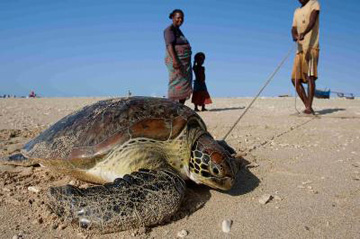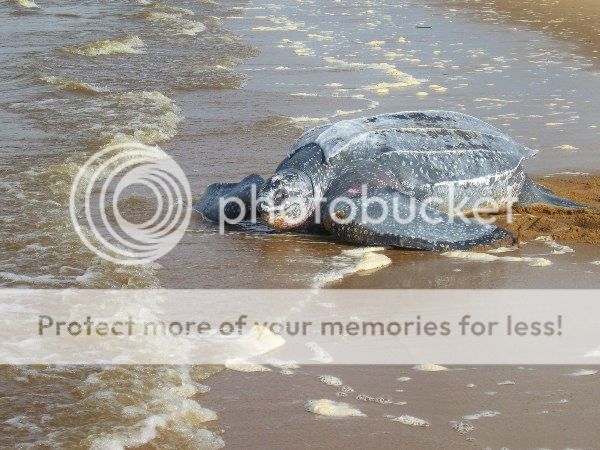Over 10,000 marine turtles are being killed in one region of Madagascar for food every year, according to a new study in Animal Conservation. Although fishing for marine turtles is illegal, it has not stopped local artisanal fishermen from pursuing four different endangered marine turtle species.
“We conducted this study because we know this small-scale, artisanal fishing is going on despite it being illegal to catch turtles under Malagasy law,” Annette Broderick, from the Center for Ecology and Conservation (Cornwall) at the University of Exeter, said in a press release. “Because turtles are an endangered species, it’s important for us to know what’s going on in the region so we can work with the local community to find a sustainable way forward.”
699 marine turtles were landed in 12 coastal villages in Madagascar, according to paid locals who kept a count. Combining these figures with previous data from the region allowed for what the researchers are dubbing a ‘conservative’ estimate of 10,000 to 16,000 marine turtles killed for food in one year. Most of the turtles were green turtles (Chelonia mydas), which are classified by the IUCN Red List as globally Endangered.
 Green sea turtle caught on an island off Madagascar. Photo by: Dr. Garth Cripps, Blue Ventures. |
One of the poorest countries in the world, it is estimated that around 70% of people in Madagascar suffer from malnutrition.
“Catching turtles for their meat is an important part of Malagasy culture for many coastal people, but the villagers also understand the importance of ensuring the future of this resource,” explains Frances Humber with Blue Ventures Conservation, a marine conservation organization that works in Madagascar. “This study is a great way of involving communities in the process of finding a sustainable way forward.”
While the study focused on Madagascar, Humber says turtles remain on the dinner table in many parts of the world, despite its illegality.
“We’d expect similar harvests in many countries in the tropical coastal developing world, so this isn’t an isolated issue, but clearly it is a cause for concern when dealing with endangered species. It’s possible the model for this study could be used elsewhere to get a better idea of numbers.”
She adds that, “clearly making turtle fishing illegal hasn’t worked, so we need to work with communities to promote sustainable practices.”
Of the seven marine turtle species in the world: three are listed as Critically Endangered, two are Endangered, one is Vulnerable, and one if Data Deficient.
Related articles
New report finds millions of marine turtles killed by fisheries, not thousands

(04/06/2010) Humankind’s appetite for seafood has had a bigger impact on the world’s marine turtles than long thought. A new report by Conservation International (CI) in partnership with Duke University’s Project GloBAL (Global By-catch Assessment of Long-lived Species) finds that in the past eighteen years it is likely millions of marine turtles have been killed as bycatch by the world’s fisheries.
Costa Rica proposes to downgrade Las Baulas National Park, threatening leatherback sea turtles

(11/11/2009) Costa Rica is considered by many to be a shining example of environmental stewardship, preserving both its terrestrial and marine biodiversity while benefiting from being a popular tourist location. However, a new move by the Costa Rican government has placed their reputation in question. In May of this year the President of Costa Rica, Oscar Arias, presented a law to the legislature that would downgrade Las Baulas from a National Park to a ‘mixed property wildlife refuge’. The downgrading would authorize a number of development projects that conservationists say would threaten the park’s starring resident: the leatherback turtle.
Scientists find world’s largest leatherback sea turtle population in Gabon

(05/17/2009) Scientists have found the world’s largest population of nesting leatherback sea turtles. On the beaches of Gabon in West Africa land and air surveys estimated the small country’s leatherback population to be between 15,730 and 41,373 individual females. The findings are published in Biological Conservation. Leatherback sea turtles are currently considered critically endangered by the IUCN, however these new numbers may cause marine biologists to reconsider that ranking.
Plastic garbage accounts for one-third of leatherback sea turtle mortalities
(03/17/2009) A new study in Marine Pollution Bulletin has confirmed that the world’s largest sea turtle is succumbing in startling numbers to an environmental issue that receives little attention: plastic trash in the oceans.
Little-known flatback sea turtle receives extra attention at symposium in Australia

(02/17/2009) Beginning today in Brisbane, Australia, the 29th annual Symposium on Sea Turtle Biology and Conservation will feature the flatback sea turtle, native to Australia and probably the least-studied of the marine turtle species. For a hundred years biologists debated as to how closely the flatback marine turtle was related to the green sea turtle. Several unique attributes of the flatback came to the forefront. The name ‘flatback’ describes the turtle’s distinct flattened carapace. The species also lays the largest eggs of any sea turtles, proportional to their size. However, perhaps most distinctly the flatback is the only marine turtle to call one nation home. The flatback forages, mates, and lays eggs along Australia’s coats; its penchant for swimming, rather than riding oceanic currents, keeps it from migrating across oceans as other turtle do.